Churchill Mark VII Crocodile Flame Thrower Tank
The Tank Museum at Bovington's British Churchill Crocodile Flame Thrower Tank is unusual from other Museums Churchill Crocodile tanks as it still has its fuel trailer.
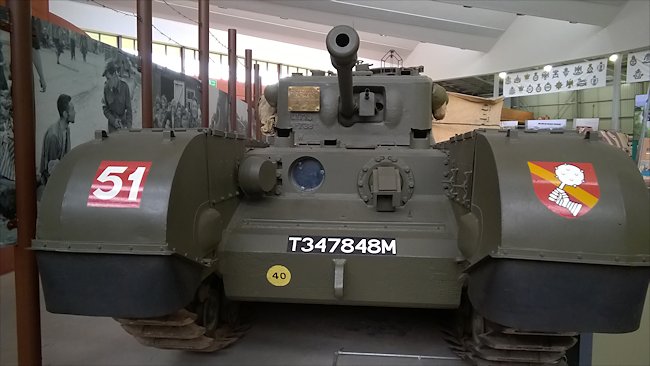
Churchill Mk VII Crocodile Flame Thrower Tank at Bovington Tank Museum. The flame came out of the nozzle in the front hull where normally there would be a machine gun.
Location
This Churchill Mk VII Crocodile Flame Thrower Tank is on display at the Tank Museum, Linsay Road, Bovington, Dorset. The nearest train station is Wool Railway Station. You can walk the 2 miles to the Museum but there are not pavements along the country road and if you are travelling with children it can be dangerous. It takes 45 minutes by foot. There is an irregular bus service from Wool Station that will get you to the museum but they only come once an hour in the morning starting after 9.30.
The last bus back to the station from the Tank Museum is just after 13.45 which is really silly. There is no Sunday bus service. The easiest way to get to the museum from the train station is by taxi. They can be pre booked with Garrison Cars to meet you when your train arrives and pick you up for the return trip from outside the museum. Their phone number is 01929 463395.
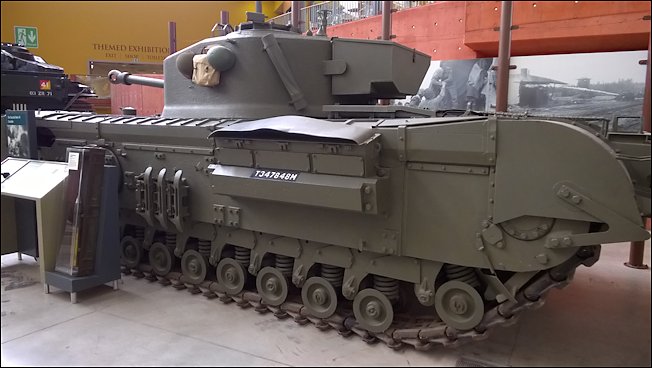
Churchill Mk VII Crocodile Flame Thrower Tank at the Bovington Tank Museum
Specifications
The Churchill MkVII was powered by a Bedford horizontally opposed twin-six petrol engine that produced 350 hp. It had a maximum road speed of only 15 mph (24 km/h) and had an operational range of around 56 miles (90 km) before it needed to refuel. It required a five man crew and they were protected by armour that ranged in thickness from 16mm to 152mm
400 imperial gallons (1,800 litres) of fuel and the compressed nitrogen propellant, enough for eighty one-second bursts, were stored in a 6.5 ton detachable armoured trailer towed by the Crocodile tank. The trailer was connected to the tank by a three way armoured coupling, that could be jettisoned from within the tank if necessary. The flame thrower had a maximum range of between 100 yards - 150 yards (120m-140m) depending on the conditions it operated in.
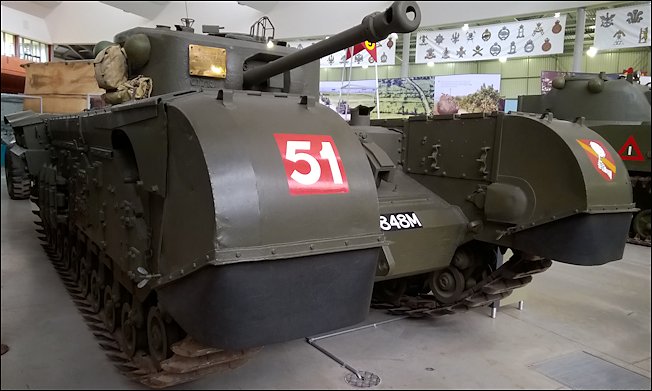
Churchill Mk VII Crocodile Flame Thrower Tank at Bovington Tank Museum
The Flame Thrower Tank
The Churchill MkVII croc was a tough tank with a deadly weapon. The armour on the front of a Churchill is much thicker than the German Tiger's, making it an incredibly strong tank. It was slow, but had an amazing ability to climb, which proved useful in the hills of Tunisia and Italy. Named after Britain's wartime Prime Minister, the Churchill first appeared in 1941, but it was riddled with mechanical problems. The much improved Mark Vll came out in 1943. The Churchill Crocodile was adapted as a flame-thrower and used from D-Day onwards. Although a deadly weapon, it was vital to use the flame gun within 30 minutes of the gas pressure being raised, otherwise it would leak away and the gun would fail.
The brass plate on the front of the Bovington Churchill MkVII turret shows that this was the last Churchill tank ever built. It came direct from the factory to The Tank Museum in 1949. The flame gun on the front of the tank is located where a machine-gun was normally fitted. Notice the large circular access doors on the sides of the tank. At the end of World War Two, Crocodile flame-throwers of 7th Royal Tank Regiment were used to burn down buildings and sterilise the ground at the typhus-ridden Belsen Concentration Camp. Typhus is a potentially fatal disease that is common in dirty, over-crowded conditions.
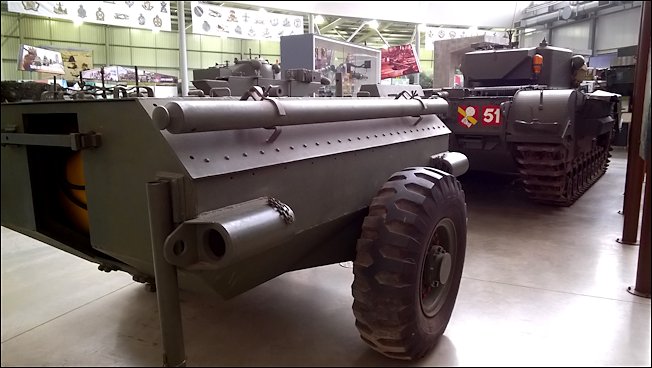
400 imperial gallons (1,800 litres) of fuel and the compressed nitrogen propellant, enough for eighty one-second bursts, were stored in a 6.5 ton detachable armoured trailer.
The sight of a flame-thrower was terrifying for enemy troops. Yet it was also nerve-wracking for its crew because of the increased danger they were in. The flame fuel was piped through the tank from the trailer to the gun, so a direct hit would cause a massive explosion. It was also very difficult to reverse the tank because of the trailer, making a quick escape near-impossible.
Crocodiles in the Battle of the Bulge
During the few days following Christmas 1944 the Allies were starting to fight back from the north of the Bulge in the Belgium Ardennes but many of the German troops were dug in. An American assault force was being held up by the newcomers of the German 9th Panzer. Some of them had holed up in a thick-walled castle ruin just outside the large village of Humain, Belgium.
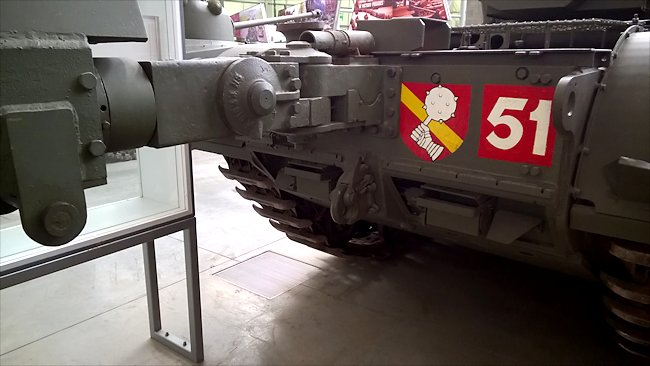
The trailer was connected to the tank by a three way armoured coupling, that could be jettisoned from within the tank if necessary.
All day long the Allies had been trying to turf the panzer men out of their positions. Once they had been dealt with, they knew that they could roll up the rest of the German defensive line. Stubbornly, however, the Germans refused to give up, and American casualties were mounting. Twice, a pause was ordered while German-speaking officers attempted to convince the defenders that they should surrender. They refused. They, too, knew that, if they gave up, the rest of the 9th Panzer's defensive fine would be forfeit.
US Gen Harmon acted. He contacted Brig Roscoe Harvey, the commander of the 29th British Armoured Brigade, and asked if he could help. The veteran of the long fighting in the Middle East had under his commanded some 'Churchill Funnies': a battle-winning weapon in close combat operations and one that, for some reason, American General Bradley had refused to employ right from the days of the Normandy invasion. In this case it was the fearsome Crocodile — a Churchill tank Chassis adapted to be used as a mobile flamethrower. In house-to-house fighting in a built-up area it was usually calculated to make enemy defenders surrender quickly.
Now the Crocodiles of the 29th's 2nd Fife and Forfar Yeomanry waddled forward into the attack on the medieval castle. They were covered by what artillery the Americans could bring to bear, for the tense troopers of the Yeomanry knew that they were at their most vulnerable during the approach. Some bold German armed with a Panzerfaust could turn the Crocodile tank and the little trailer it towed, containing its fuel, into an all-consuming inferno. Then they would suffer the same fate that they had intended for the enemy.
The lead Crocodile got closer and closer. Slugs pattered off its armoured sides like heavy tropical rain on a tin roof. Still the Yeomanry kept on. The veterans of Normandy, Antwerp and the subsequent fighting in Holland knew that they might have a matter of minutes to live. They swept around the piles of smoking battle rubble everywhere. Now the Gothic walls of the castle loomed ever larger. The gunner sighted his terrible weapon. He aimed — as a kind of last demonstration for the real thing — at a large tree just in front of the castle. If the 'Jerries' didn't surrender after that, well, it'd be their hard luck.
The tank commander hissed an order. The gunner gasped. He fired. A long red flame, tinged with black oily smoke, shot from the cannon. In its front, the dirty snow hissed, recoiled like a live thing and disappeared. There was the acrid stink of burning. The next moment that all-consuming, terrible flame coiled itself around the lone tree. It ignited at once. In a flash, despite its snowbound, sodden state, it was burning furiously, lighting up the courtyard like day, before shriveling away to grey ash in a few Minutes.
Harmon recalled later, 'This spectacular exhibition proved to be effective propaganda, A few minutes later, 200 German soldiers marched out into the courtyard with their hands held high, They had seen enough.'
WW2 tank books

